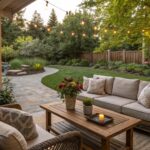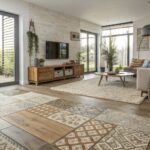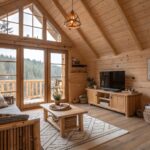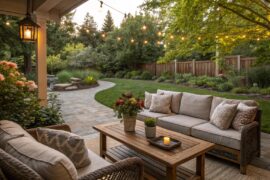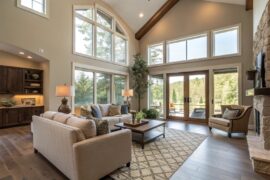The spaces children inhabit become the landscapes of their memories. When thoughtfully designed, these environments don’t just house childhood experiences—they actively shape them, creating the backdrop for core memories that last a lifetime. As designers of children’s spaces, we have the privilege of crafting the physical contexts where lifelong memories take root.
Understanding How Children Experience Space
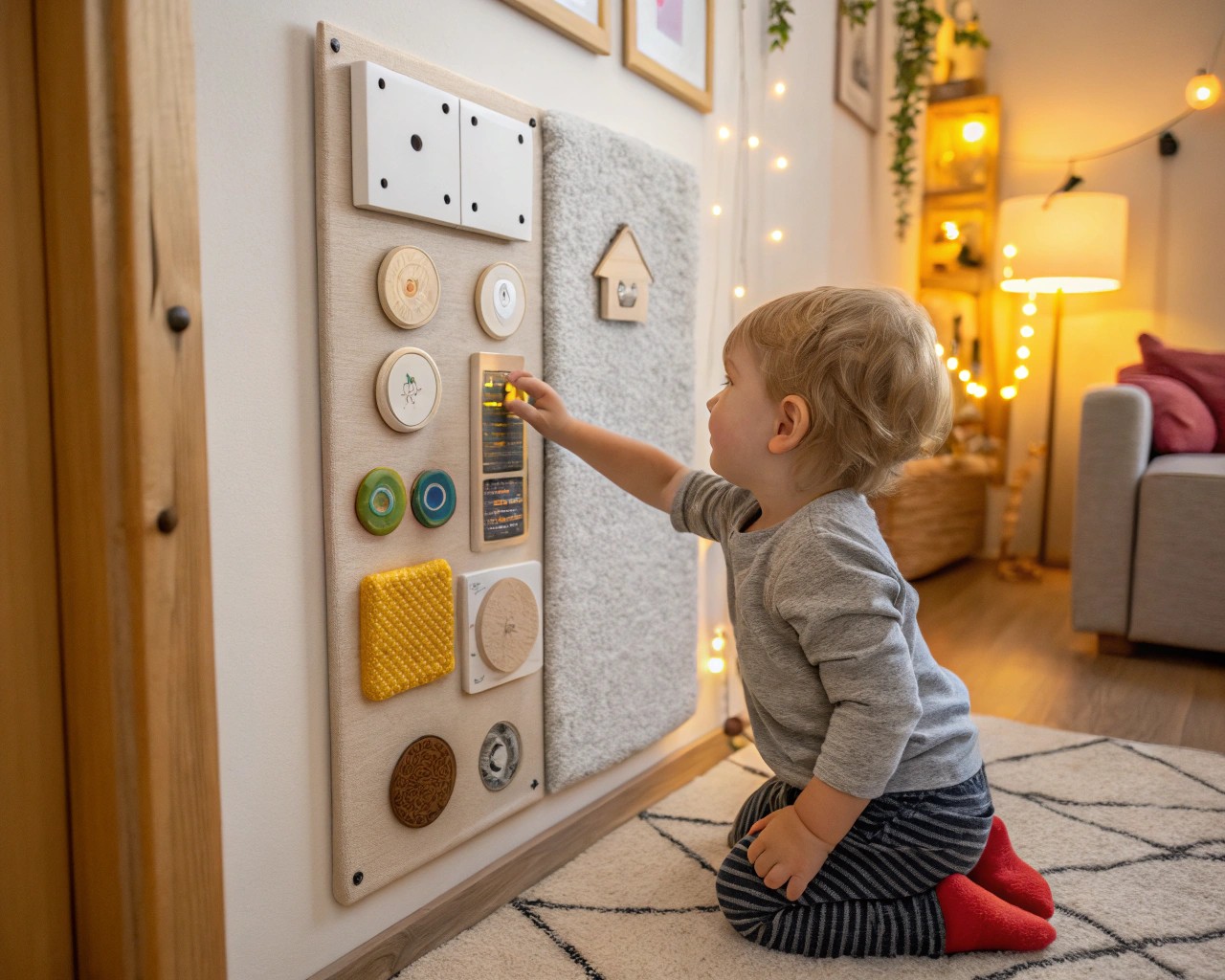
Children perceive their surroundings differently than adults do—more sensory-driven, more immediate, and from a literally different perspective. This unique perception influences how memories form and persist.
Sensory Experiences and Memory Formation
Studies suggest that incorporating biomorphic elements (forms and patterns found in nature) into interior designs can make spaces more memorable and pleasant, while also capturing more visual attention. When designing for children, we must consider all sensory dimensions:
- Visual stimulation: Colors, patterns, light variations
- Tactile experiences: Diverse textures, temperature differences
- Sounds: Acoustic qualities, intentional sound elements
- Scents: Natural materials, distinctive plant aromas
- Movement: Opportunities for varied physical interaction
I’ve observed throughout my career that the most memorable spaces engage multiple senses simultaneously. One client shared how her son would still talk about the “whispering wall” in his playroom years later—a curved alcove where sound traveled in unexpected ways, creating a sense of wonder that became central to his childhood memories.
Scale and Perspective
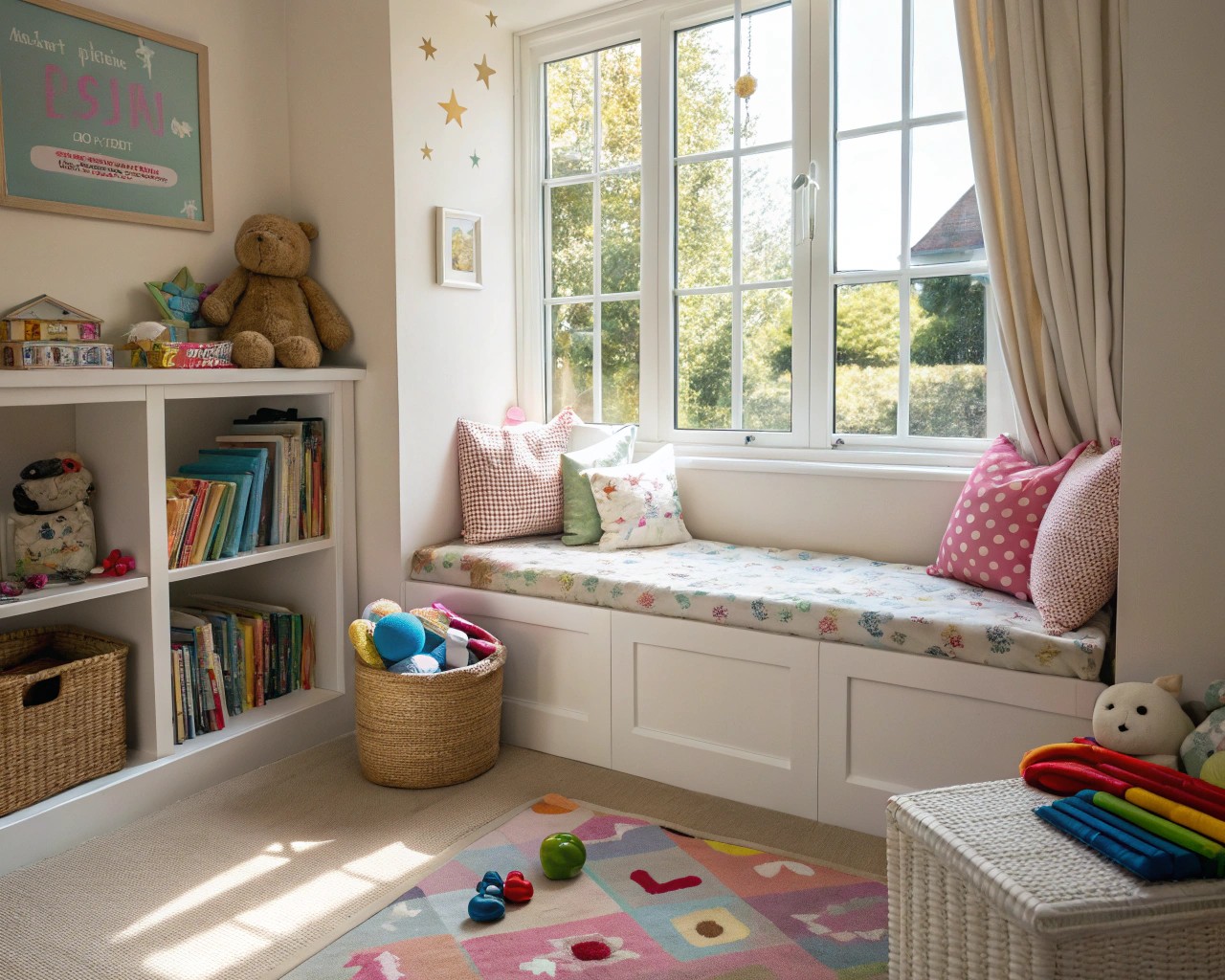
Children experience spaces from a different physical perspective. Designing at child scale creates feelings of ownership and autonomy:
- Lower viewpoints and windows
- Child-proportioned furniture and features
- Accessible storage and displays
- Cozy nooks that feel perfectly sized
Core Memory Formation
Research on childhood garden memories reveals that favorite places often feature specific qualities:
- Secret or hidden spaces
- Natural elements that change with seasons
- Places that allow for personal adaptation
- Areas that support social connection and imaginative play
Principles for Designing Memory-Making Spaces
Based on research and professional experience, four key principles guide the creation of meaningful children’s spaces:
Sense of Place
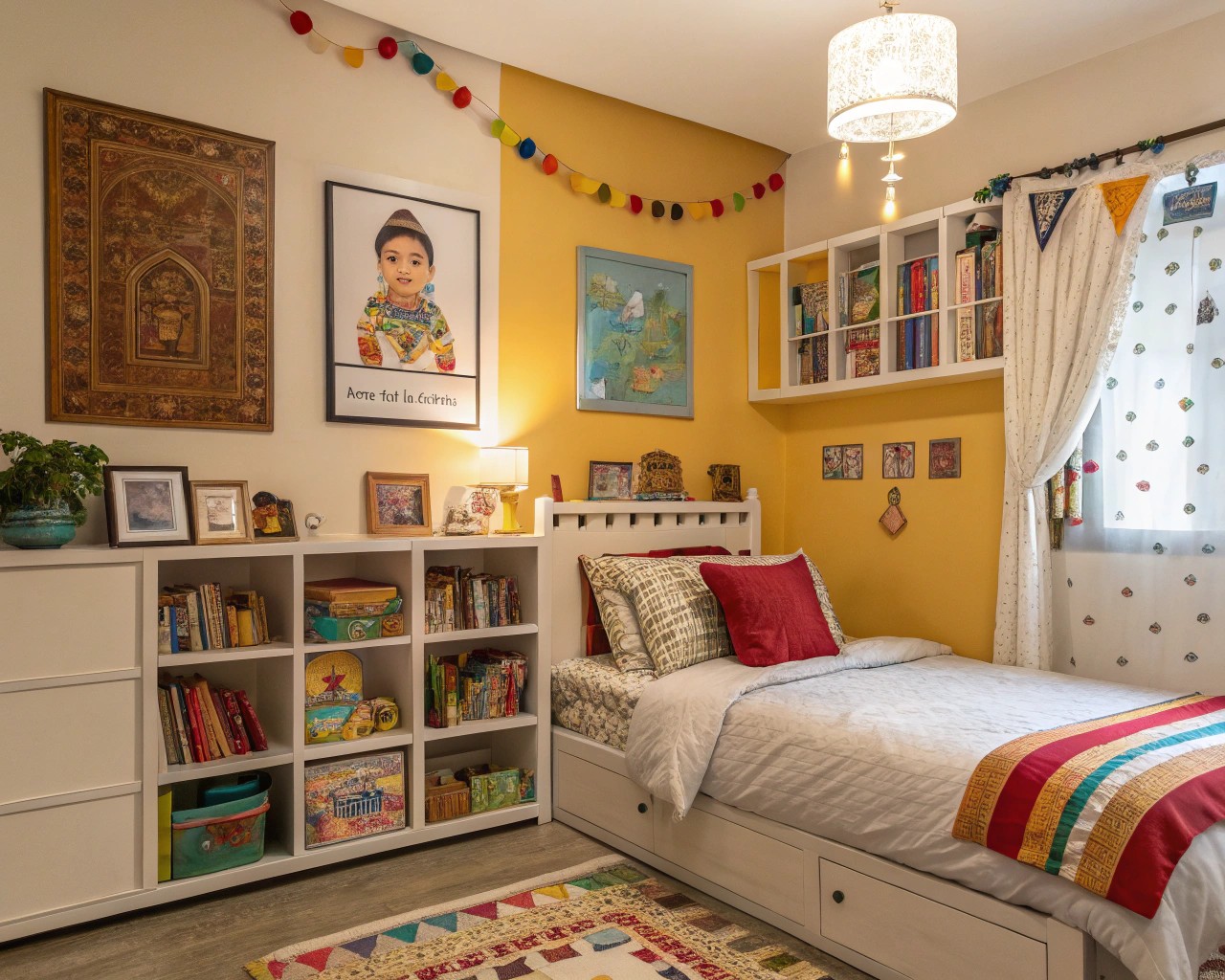
Children develop confidence by connecting with their immediate environment. Design elements that reflect the local community, cultural context, and family identity help children develop a sense of belonging and place-attachment.
One landscape architect emphasizes the importance of developing this sense of place by researching the area’s history and weaving design elements reflective of the community’s character into the project. This approach aims to reduce anxiety and create joyful environments conducive to learning and growth.
Well-being
Spaces that support physical, emotional, and social well-being become positive anchors in memory. This includes:
- Abundant natural light
- Good ventilation
- Acoustic comfort
- Physical activity opportunities
- Spaces for both social interaction and quiet reflection
Sensory Richness
Memory-making spaces engage multiple senses through:
- Varied textures and materials
- Changing light conditions
- Natural elements with seasonal variation
- Intentional acoustic properties
- Scent-producing plants or materials
I recall designing a children’s reading corner where dappled light filtered through a custom-cut screen, creating ever-changing patterns on the floor. Years later, the now-teenage client mentioned it was still her “thinking spot” because of how the light made her feel.
Adaptability and Personalization
Spaces that allow children to modify and personalize become more deeply connected to their identity and memory. Research suggests that children’s behavior patterns within a garden setting can be influenced by their natural inclination for direct experiences. Consider incorporating:
- Flexible furniture arrangements
- Display areas for creations and collections
- Elements that can be moved or reconfigured
- Areas that can grow and adapt with the child
Indoor Spaces That Foster Core Memories
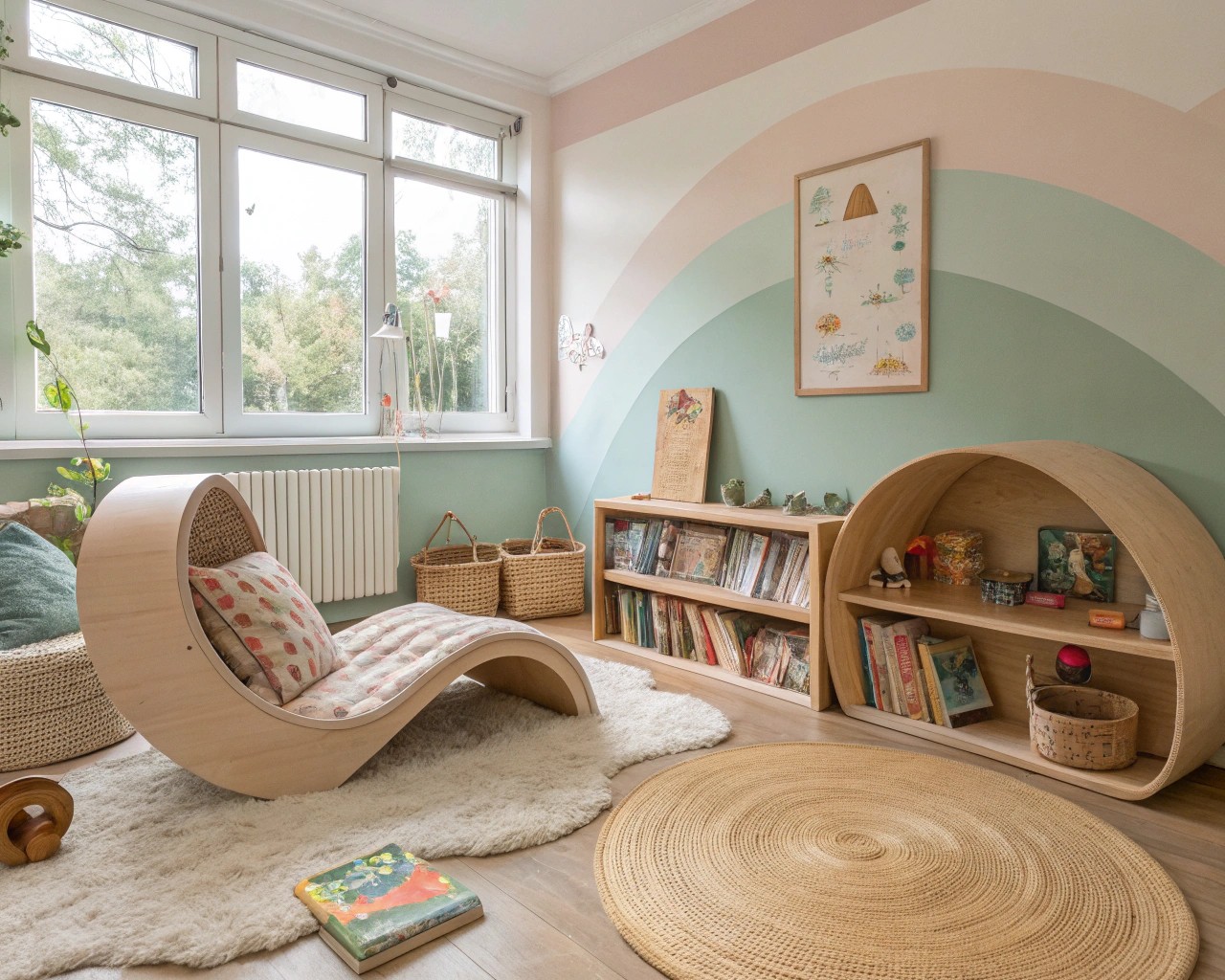
Biomorphic Elements and Memory Retention
Studies confirm that indoor environments featuring biomorphic elements—those mimicking natural shapes and patterns—tend to be more memorable and pleasant, while also holding visual attention more effectively. Incorporating these natural forms, patterns, and materials enhances both the memorability and enjoyment of spaces.
Consider including:
- Curved forms rather than exclusively straight lines
- Natural materials (wood, stone, plant fibers)
- Nature-inspired patterns and textures
- Living elements like plants
- Water features where practical
Creating Zones and Nooks
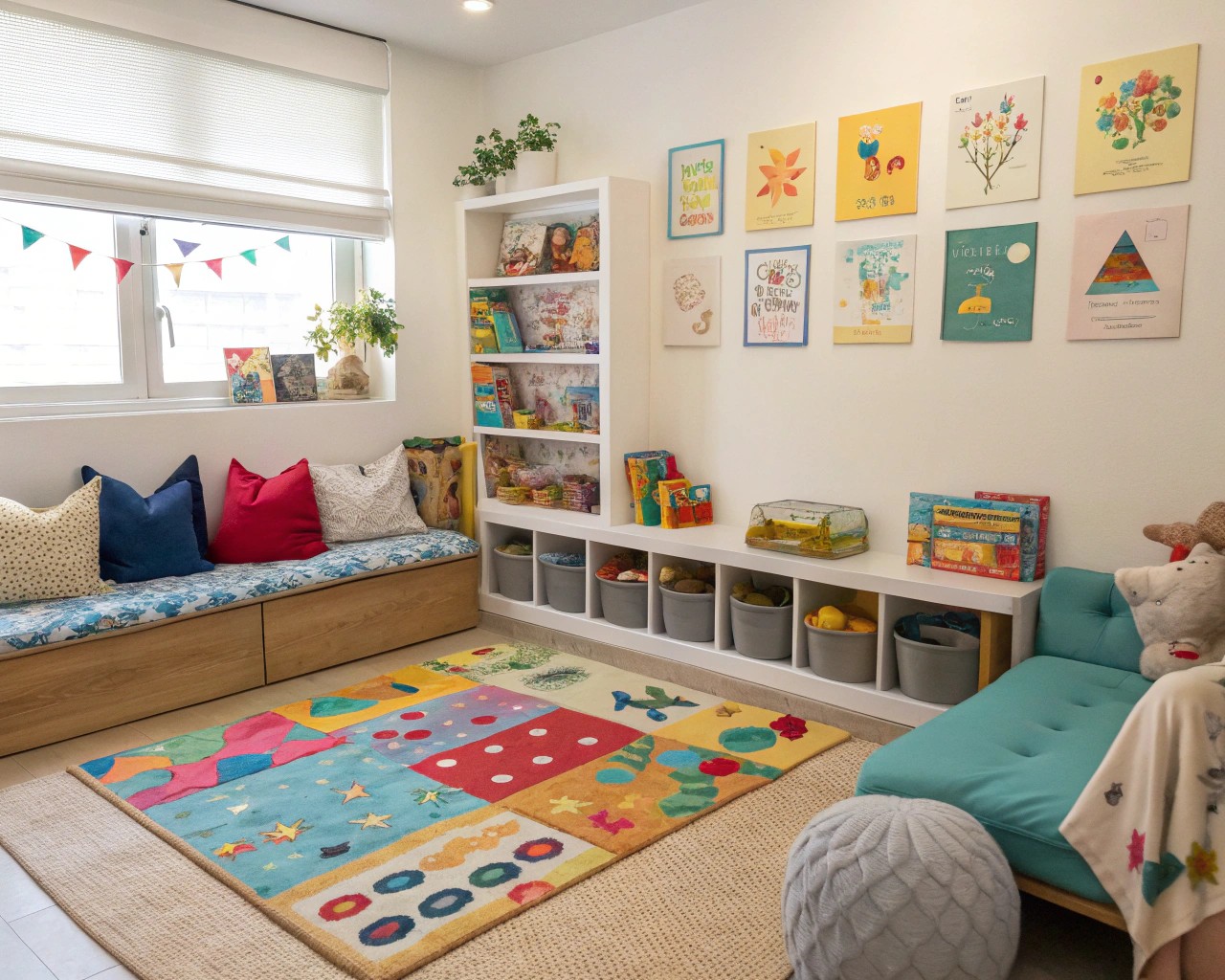
Children benefit from spaces that offer variety and different types of experiences. Consider creating:
- Active zones: Areas for movement and energetic play
- Social zones: Spaces designed for interaction and group activities
- Creative zones: Well-equipped areas for artistic expression
- Quiet zones: Cozy, comfortable spaces for retreat and reflection
In my experience, the quiet zones often become the most cherished in memory. One family reported their daughter’s window seat—a simple cushioned nook with pillows and a curtain—became her “thinking spot” that she recreated in every home they lived in thereafter.
Child-Scale Design Elements by Age
The following table outlines key design elements organized by age group:
| Age Group | Scale Considerations | Storage Solutions | Safety Elements | Special Features |
|---|---|---|---|---|
| 0-2 years | Floor-based play areas, low windows, crawling tunnels | Low open shelves, picture labels | Rounded edges, soft surfaces, anchored furniture | Mirrors at floor level, textured walls |
| 3-5 years | Child-height windows, adjustable tables | Picture and word labels, accessible hooks | Non-toxic materials, visible boundaries | Display spaces for creations, dramatic play areas |
| 6-9 years | Mix of heights, climbing elements | Independent organization systems | Age-appropriate tools, clear pathways | Secret spaces, flexible furniture |
| 10-12 years | Adult-scale with child options, personalized spaces | Complex organization, personal storage | Independence in space usage | Areas for collections, social spaces |
Safety Without Limitation
Effective children’s spaces balance safety with the need for appropriate risk and challenge. Rather than eliminating all risk, it’s important to prioritize safety through thoughtful design choices. This involves using child-friendly, non-toxic, easy-to-clean materials, incorporating rounded edges on furniture, ensuring non-slip flooring, and implementing secure storage to prevent accidents while still allowing for exploration. Consider:
- Clear boundaries for truly dangerous areas
- Graduated challenges that build skills
- Natural consequences for minor risks
- Supervision zones that allow independence while maintaining safety
Outdoor Spaces and Memory Gardens
Gardens and outdoor spaces feature prominently in childhood memories. Research on garden memories reveals that many adults recall specific plants, scents, and hiding spots from childhood gardens with remarkable clarity, even decades later.
Elements of Memory-Making Gardens
The following elements tend to create lasting garden memories:
- Secret spaces: Hidden areas, child-sized vegetation for hiding
- Water features: From simple puddles to streams and ponds
- Climbing opportunities: Trees, mounds, appropriate structures
- Loose parts: Natural materials that can be moved and manipulated
- Edible plants: Fruit trees, berry bushes, vegetables
- Wildlife habitats: Areas that attract birds, butterflies, and insects
- Weather experiences: Places to experience rain, wind, sun, and shade
A client once shared that forty years later, she could still recall the exact feeling of crawling into a hollowed-out space beneath a rhododendron in her childhood garden—it became her thinking space, reading nook, and imaginary home. This influenced our design of a children’s garden with multiple “secret” spaces scaled for different ages.
Natural Elements and Seasonal Change
Gardens that showcase seasonal changes create layered memories throughout the year. Consider:
- Plants with distinctive seasonal features
- Areas to interact with natural elements (leaves, snow, rain)
- Spaces that transform with the seasons
- Deliberate sensory experiences tied to weather and seasons
As one garden designer reflects, “I find it interesting when taking the design brief with a client how many will say something along the lines of ‘Oh I love [insert plant] because my grandmother had them in her garden,’ or ‘I remember picking [insert plant] when I was a child'”.
Child-Directed Exploration
Studies suggest children greatly benefit from natural environments that encourage direct, hands-on exploration. Design considerations include:
- Balanced risk opportunities
- Multiple pathways and options
- Varied terrain and elevation
- Natural loose parts for manipulation
- Water play opportunities
- Digging areas and malleable materials
Involving Children in the Design Process
Children’s participation in the design process can enhance their connection to a space and deepen memory formation. Research highlights that many gardens aim to foster environmental stewardship through positive experiences; thus, involving children in the design itself can be a valuable part of this learning process.
Age-appropriate participation might include:
- Observation of play patterns and preferences
- Photo documentation of favorite places
- Drawing exercises to express desires
- Model-making for older children
- Material and color selection
- Construction participation where safe and appropriate
I’ve found that children as young as three can meaningfully contribute to design decisions when given appropriate tools. In one research project, children were provided with cameras to photograph their “important things” in an existing space, which revealed priorities adults might otherwise have missed.
Questions to Ask Children During Design
When involving children in the design process, consider asking:
- “If you want to be with your friends at [space], where do you like to go?”
- “If you want to be by yourself at [space], where could you go?”
- “What’s your favorite place to play?”
- “Where do you feel happiest in this space?”
- “What would make this place even better?”
Case Studies
Case Study 1: The Little School
The Little School provides dedicated space for toddlers to 3-year-old students, designed with a Reggio-Emilia-inspired approach.
Key Design Elements:
- A large, inviting central piazza for welcoming students and parents
- Project studio with loose parts and natural elements
- Nature-based play space
- Connection between interior and exterior spaces
- Wrap-around porch for outdoor time even during rain
- Floor-to-ceiling window panes that fully open
Memory-Making Features:
- Direct access to outdoors from all classrooms
- Panoramic views to outside world
- Spaces at various scales for different types of interaction
- Natural light and fresh air integration
Case Study 2: Kid-Sense Garden
This garden was specifically designed to engage multiple senses and create memorable experiences for children:
Design Elements:
- Textured pathways with different materials
- Aromatic plants strategically placed at child height
- Sound-making features activated by wind or touch
- Edible garden section with seasonal harvests
- Water feature with safe interactive elements
- Secret spaces and hideaways scaled for different ages
- Areas for creative expression and manipulation
Parent Feedback:
“My children have developed specific rituals in different parts of the garden. The sensory elements have become reference points in their vocabulary—’the crunchy path,’ ‘the whispering grass,’ ‘the fuzzy leaves’—showing how deeply these elements have embedded in their experience.”
Documenting Childhood Spaces and Memories
Creating systems to document and preserve childhood memories can extend the impact of thoughtfully designed spaces.
Filing System for Childhood Memories
One practical approach is creating a dedicated storage system for each child:
- Use a storage box with hanging files
- Create files for each year (ages 0-18)
- Use two folders in each hanging file:
- One for important papers (medical documents, report cards, etc.)
- One for artwork and classwork
- Label files clearly and consistently
- Sort items as they come into the home
Memory Book Design Ideas
Memory books can capture the special relationship between children and their environments:
- Include photos of favorite places and spaces
- Add child commentary about special spots
- Insert physical mementos (tickets, pressed leaves, etc.)
- Document seasonal changes in favorite places
- Include messages from important people in their lives
- Add decorative elements that reflect the child’s personality
While photo albums preserve images, a memory book can offer something more profound. By adding context—notes about the pictures, personal thoughts, descriptions of moments and feelings from childhood—the memory book becomes a far more personal and evocative keepsake than a standard photo album.
Design Elements Checklist
When designing spaces that create core memories for children, consider this practical checklist:
Observation and Research
- [ ] Observe how children currently use the space
- [ ] Document existing favorite spots or features
- [ ] Interview children about their preferences
Sensory Elements
- [ ] Visual interest at multiple heights
- [ ] Varied textures for tactile exploration
- [ ] Acoustic considerations (both sound and quiet)
- [ ] Natural scents and aromas
- [ ] Opportunities for varied movement
Scale and Access
- [ ] Child-height viewpoints and windows
- [ ] Appropriately sized furniture and features
- [ ] Independent access to materials and tools
- [ ] Clear pathways and navigation
Memory-Making Features
- [ ] Secret or hidden spaces
- [ ] Connection to natural elements
- [ ] Seasonal variations and changes
- [ ] Personalization opportunities
- [ ] Documentation areas (display spaces, memory collections)
Safety and Inclusion
- [ ] Appropriate risk and challenge
- [ ] Universal design principles
- [ ] Clear boundaries where needed
- [ ] Supervision without intrusion
https://journals.sagepub.com/doi/abs/10.1111/joid.12224
https://ecommons.cornell.edu/bitstream/1813/14757/1/Miller,%20Ashley.pdf
https://files.eric.ed.gov/fulltext/ED522693.pdf
https://evergreen.ca/resource-hub/wp-content/uploads/2024/04/landscape-child-development.pdf



